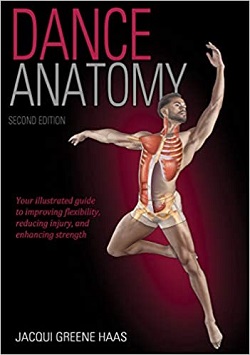I love anatomy. As a yoga instructor, dancer, and writer in yoga and dance, it’s endlessly fascinating to me and applicable to my daily work. I am eternally grateful for my dance education (at a hometown studio, in a liberal arts university dance program, and countless other studios and teachers beyond that). Yet, if I take a moment for honest reflection, experiential learning of anatomy — in ways that inform technique, artistry and kinesthetic knowing in essential ways — felt lacking. I’ve heard fellow dancers express similar sentiments. That experiential learning of anatomy from a dance lens is what Jacqui Greene Haas’s Dance Anatomy can offer. The subtitle — Your illustrated guide to improving flexibility, muscular strength and tone — is a great start to understanding what the text provides.
The book begins with an intriguing preface by the author, explaining what the book will offer and how it’s laid out. The first chapter introduces fundamental anatomical topics — including planes of motion (sagittal, frontal and transverse), types of joint movements (such as flexion and extension) and different types of muscle contractions (isometric, concentric, eccentric). At times, it does feel like a lot of information for readers to take in at once, even for someone like me who’s taken several anatomy courses, and that some of the jargon could have been swapped out for more familiar language.

Yet, functionally, what Haas is doing is steeping readers in the language of anatomists, doctors and physical therapists. From there, dancers can feel more empowered and confident in conversations with healthcare providers, in anatomy coursework and the like. Additionally, the beauty of books is that we can take them in on our own terms, as much as our life might realistically allow — reading lines or paragraphs over again in the moment or coming back to sections of text (or even whole books) later, for example.
Following this foundational chapter are chapters on sections of the body that are particularly important to dancers in the anatomical sense — spine, ribs/breath, core, shoulder girdle and arms, pelvis and hips, legs, and ankles/feet. The chapters have a consistent format, with an introduction to important principles of the anatomical region at hand followed by exercises to target specific goals within that region. Those goals include strengthening, kinesthetic awareness, release to allow for healthy movement initiations and patterns, coordination with breath to assist with all of those outcomes, and more.
Each exercise also has a “Dance Focus”, an explanation on how the exercise relates to a certain technical function or common movement. This feels helpfully applicable and tangible for dance artists, whose primary concern is most likely what all of this learning will do for their technique and artistry. In terms of language in both sections, when Haas uses familiar and evocative images to guide readers toward certain goals, it feels more accessible and likely more effective than when she uses muscle names and other anatomical jargon. Although again, perhaps the approach with using anatomical jargon is that “trial-by-fire” (so to speak) training in the science of anatomy to educate and empower dancers in this discipline.
Additionally, readers, take note — some of these exercises call for props and tools such as physioballs, TheraBands, ballet barres, weights and more. Haas does include modifications for exercises, to “level up” or “level down”, thus working to accommodate various types of bodies. She also lists important safety tips along with many (if not most) of the exercises. Just as the anatomical language can empower dancers in medical and academic spaces, these safety tips can begin teaching dancers how to cross-train safer. “Conditioning principles” in the introductory chapter can complement that knowledge, adding a framework that can increase cross-training effectiveness.
A review of this text would be incomplete without discussing the beautifully drawn illustrations. Refined sketches in semi-silhouette allow muscles in focus to be seen right where they are in the body. In an intriguing and lovely way, the nuances of physical energy in these two-dimensional dancers-in-motion are clear. Some drawings of the exercises include arrows to indicate direction of movement and/or change of physical placement, and that’s another element that could have been included more for greater accessibility of the content. The most prescient element of the illustrations that I’d like to call forth, however, is my main criticism of the book — that of inadequate representation, of both dancers and dance forms.
For example, the first Black dancer shows up a few chapters in (race evident from elements such as hair texture, shading of the skin in the drawings and other physical attributes — granted, again beautifully drawn). Only a handful of others show up in the book’s illustrations as a whole — numbering over a hundred, I’d guess. There are no Latinx, Asian or Indigenuous dancers, from what I could tell (again, the drawings are detailed enough that race seems fully evident). Regarding dance forms, it’s great to see forms such as Irish step dance and ballroom represented, considering what can feel like the dominance of ballet and contemporary dance in professional concert dance. Yet, those forms are also based in Western culture traditions. It would have been wonderful to also see hip hop, African dance and other folk dances — perhaps even capoeira!
Why should that matter? If we care about dancer health, wellness and creative success, we need to care about dancers who look like them and dance like them being reflected in the media, pop culture and academia. Granted, Dance Anatomy was published in 2010. Representation in dance is not a new conversation, but it has certainly ramped up and the field has taken more tangible action on the issue since then. Yet, we’re also reading this book in 2020 (or beyond). We can be gracious in acknowledging the world it was written in and also look at with the eyes of today; we can hold both things in our minds, heart and body.
Overall, however, Haas’s Dance Anatomy offers a way for dancers to learn dance-based anatomy that can truly resonate and last — through the body, the vessel through which dancers are already so intimately acquainted. Becoming even more intimately acquainted, in a knowledgeable and outcome-driven way, can make all the difference; deepened artistry, expanded kinesthetic knowing and safer, stronger technique can bloom from there.
By Kathryn Boland of Dance Informa.













